Numerical Simulation on Borehole Instability Based on Disturbance State Concept
Abstract
:1. Introduction
2. Theory and Method
2.1. Mechanical Equilibrium Equation
2.2. Seepage Equations
2.3. Theory of DSC Borehole Instability
2.4. Model Validation
3. Finite Element Model
4. Results and Analysis
4.1. Effect of Action Time of Drilling Fluid on the Wellbore
4.2. Effect of Stress Anisotropy
4.3. Effect of the Internal Friction Angle of Rock
4.4. Effect of Borehole Pressure
5. Conclusions
- (1)
- The finite element numerical simulation results show that borehole stability is related to the action time of drilling fluid on the wellbore, stress anisotropy, internal friction angle of rock, and borehole pressure. Excessive drilling fluid density and long action time between the drilling fluid and the borehole should be avoided. Under the small stress anisotropy, shear failure occurs often around the borehole. A high horizontal stress difference restricts shear instability around the borehole. The high internal friction angle of rock enhances shear failure around the borehole in the direction of the maximum horizontal principal stress.
- (2)
- The equivalent plastic strain zone has a good agreement with the borehole instability disturbance damage zone, and they show the same characteristics. A high internal friction angle of rock, low stress anisotropy, and long action time of the drilling fluid on the wellbore enlarge the plastic zone and disturbance damage zone around the borehole.
- (3)
- The model of borehole stability considers the variation of rock permeability, rock porosity, and equivalent plastic strain with the disturbance damage factor. Under the large borehole pressure and the low stress anisotropy, the rock permeability, the disturbance damage factor, and the equivalent plastic strain show fluctuation characteristics, which is due to the different damage magnitudes. When considering the internal friction angle of rock, the rock permeability, disturbance damage factor, and equivalent plastic strain area show fluctuation characteristics.
- (4)
- Under the large internal friction angle of rock, a strong equivalent plastic strain zone and a disturbance damage zone occur in the direction of the maximum horizontal principal stress, and they correspond to the mantis shape. The bifurcation corresponds to the whisker, which is the shear failure area. Under the low internal friction angle of rock, the equivalent plastic strain and disturbance damage region show chaotic features, and an elongated equivalent plastic strain region occurs along the diagonal.
Author Contributions
Funding
Institutional Review Board Statement
Informed Consent Statement
Data Availability Statement
Conflicts of Interest
References
- Yu, M.; Chen, G.; Chenevert, M.E.; Sharma, M.M. Chemical and Thermal Effects on borehole stability of Shale Formations. In Proceedings of the SPE Annual Technical Conference and Exhibition, New Orleans, LA, USA, 30 September–3 October 2001. [Google Scholar]
- She, H.; Hu, Z.; Qu, Z.; Zhang, Y.; Guo, H. Determination of the Hydration Damage Instability Period in a Shale Borehole Wall and Its Application to a Fuling Shale Gas Reservoir in China. Geofluids 2019, 2019, e3016563. [Google Scholar] [CrossRef]
- Han, Q.; Qu, Z.; Ye, Z. Research on the Mechanical Behaviour of Shale Based on Multiscale Analysis. R. Soc. Open Sci. 2018, 5, 181039. [Google Scholar] [CrossRef] [PubMed]
- Freij-Ayoub, R.; Tan, C.; Clennell, B.; Tohidi, B.; Yang, J. A borehole stability Model for Hydrate Bearing Sediments. J. Pet. Sci. Eng. 2007, 57, 209–220. [Google Scholar] [CrossRef]
- Zhang, J.; Bai, M.; Roegiers, J.-C. Dual-Porosity Poroelastic Analyses of borehole stability. Int. J. Rock Mech. Min. Sci. 2003, 40, 473–483. [Google Scholar] [CrossRef]
- Salehi, S.; Hareland, G.; Nygaard, R. Numerical Simulations of borehole stability in Under-Balanced-Drilling Wells. J. Pet. Sci. Eng. 2010, 72, 229–235. [Google Scholar] [CrossRef]
- Desai, C.C. A Consistent Finite Element Technique for Work-Softening Behavior; University of Texas: Austin, TX, USA, 1974. [Google Scholar]
- Desai, C.S.; Ma, Y. Modelling of Joints and Interfaces Using the Disturbed-State Concept. Int. J. Numer. Anal. Methods Geomech. 1992, 16, 623–653. [Google Scholar] [CrossRef]
- Katti, D.R.; Desai, C.S. Modeling and Testing of Cohesive Soil Using Disturbed-State Concept. J. Eng. Mech. 1995, 121, 648–658. [Google Scholar] [CrossRef]
- Desai, C.S.; Samtani, N.C.; Vulliet, L. Constitutive Modeling and Analysis of Creeping Slopes. J. Geotech. Eng. 1995, 121, 43–56. [Google Scholar] [CrossRef]
- Desai, C.S.; Toth, J. Disturbed State Constitutive Modeling Based on Stress-Strain and Nondestructive Behavior. Int. J. Solids Struct. 1996, 33, 1619–1650. [Google Scholar] [CrossRef]
- Desai, C.; Park, I.; Shao, C. Fundamental yet Simplified Model for Liquefaction Instability. Int. J. Numer. Anal. Methods Geomech. 1998, 22, 721–748. [Google Scholar] [CrossRef]
- Pal, S.; Wathugala, G.W. Disturbed State Model for Sand-Geosynthetic Interfaces and Application to Pull-out Tests. Int. J. Numer. Anal. Methods Geomech. 1999, 23, 1873–1892. [Google Scholar] [CrossRef]
- Fan, R.-D.; Liu, M.; Du, Y.-J.; Horpibulsuk, S. Estimating the Compression Behaviour of Metal-Rich Clays via a Disturbed State Concept (DSC) Model. Appl. Clay Sci. 2016, 132–133, 50–58. [Google Scholar] [CrossRef]
- Ouria, A. Disturbed State Concept–Based Constitutive Model for Structured Soils. Int. J. Geomech. 2017, 17, 04017008. [Google Scholar] [CrossRef]
- Ghazavi Baghini, E.; Toufigh, M.M.; Toufigh, V. Analysis of Pile Foundations Using Natural Element Method with Disturbed State Concept. Comput. Geotech. 2018, 96, 178–188. [Google Scholar] [CrossRef]
- Wu, G.; Zhang, L. Analysis on post-failure behaviors of rock in uniaxial compression using disturbed state concept theory. Chin. J. Rock Mech. Eng. 2004, 10, 1628–1634. [Google Scholar] [CrossRef]
- Zheng, J.; Ge, X.; Sun, H. Application of disturbed state concept to issues in geotechnical engineering. Chin. J. Rock Mech. Eng. 2006, 25, 3456–3462. [Google Scholar]
- Zheng, J.; Ge, X.; Sun, H. Meso analysis for rationality of disturbed state concept theory on utilization of hardening model for softening response depiction. Rock Soil Mech. 2007, 28, 127–132. [Google Scholar]
- Zhang, X.; Wang, C. Study of creep constitutive model of structural soft soil based on the disturbed state concept. China Civ. Eng. J. 2011, 44, 81–87. [Google Scholar]
- Fu, P.; Chu, X.; Yu, C.; Xu, Y.; Qu, W. Simulation of Strain Localization of Granular Materials Based on Disturbed State Concept. J. South China Univ. Technol. Sci. Ed. 2014, 42, 59–69+76. [Google Scholar]
- Yang, J.; Yin, Z.; Huang, H.; Jin, Y.; Zhang, D. Bounding surface plasticity model for structured clays using disturbed state concept-based hardening variables. Chin. J. Geotech. Eng. 2017, 39, 554–561. [Google Scholar]
- Huang, M.; Jiang, Y.; Wang, S.; Deng, T. Identification of the creep model and its paramters of soft rock on the basis of disturbed state concept. Chin. J. Solid Mech. 2017, 38, 570–578. [Google Scholar]
- Zou, Y.; Wei, C.; Chen, H.; Zhou, J.; Wan, Y. Elastic-plastic model for gas-hydrate-bearing soils using disturbed state concept. Rock Soil Mech. 2019, 40, 2653–2662. [Google Scholar]
- Cao, W.; Deng, J.; Liu, W.; Yu, B.; Tan, Q.; Yang, L.; Li, Y.; Gao, J. Pore Pressure and Stress Distribution Analysis around an Inclined borehole in a Transversely Isotropic Formation Based on the Fully Coupled Chemo-Thermo-Poroelastic Theory. J. Nat. Gas Sci. Eng. 2017, 40, 24–37. [Google Scholar] [CrossRef]
- Liang, C.; Chen, M.; Jin, Y.; Lu, Y. borehole stability Model for Shale Gas Reservoir Considering the Coupling of Multi-Weakness Planes and Porous Flow. J. Nat. Gas Sci. Eng. 2014, 21, 364–378. [Google Scholar] [CrossRef]
- Kang, Y.; Yu, M.; Miska, S.Z.; Takach, N. Borehole Stability: A Critical Review and Introduction to DEM. In Proceedings of the SPE Annual Technical Conference and Exhibition, New Orleans, LA, USA, 4–7 October 2009. [Google Scholar]
- Chen, G.; Chenevert, M.E.; Sharma, M.M.; Yu, M. A Study of borehole stability in Shales Including Poroelastic, Chemical, and Thermal Effects. J. Pet. Sci. Eng. 2003, 38, 167–176. [Google Scholar] [CrossRef]
- Zeynali, M.E. Mechanical and Physico-Chemical Aspects of borehole stability during Drilling Operations. J. Pet. Sci. Eng. 2012, 82–83, 120–124. [Google Scholar] [CrossRef]
- Gao, L.; Shi, X.; Liu, J.; Chen, X. Simulation-based three-dimensional model of wellbore stability in fractured formation using discrete element method based on formation microscanner image: A case study of Tarim Basin, China. J. Nat. Sci. Eng. 2022, 97, 104341. [Google Scholar] [CrossRef]
- Ma, T.; Zhang, Y.; Qiu, Y.; Liu, Y.; Li, Z. Effect of parameter correlation on risk analysis of wellbore instability in deep igneous formations. J. Pet. Sci. Eng. 2022, 208, 109521. [Google Scholar] [CrossRef]
- Cao, W.; Liu, W.; Liu, H.; Lin, H. Effect of formation strength anisotropy on wellbore shear failure in bedding shale. J. Pet. Sci. Eng. 2022, 208, 109183. [Google Scholar]
- Liu, D.; Deng, H.; Zhang, Y. Research on the Wellbore Instability Mechanism of Air Drilling Technology in Conglomerate Formation. Fresen. Environ. Bull. 2020, 29, 600–606. [Google Scholar]
- Liu, H.; Cui, S.; Meng, Y.; Li, Z.; Yu, X.; Sun, H.; Zhou, Y.; Luo, Y. Rock mechanics and wellbore stability of deep shale during drilling and completion processes. J. Pet. Sci. Eng. 2021, 205, 108882. [Google Scholar] [CrossRef]
- Aslannezhad, M.; Kalantariasl, A.; Keshavarz, A. Borehole stability in shale formations: Effects of Thermal-Mechanical-Chemical parameters on well design. J. Nat. Gas Sci. Eng. 2021, 88, 103852. [Google Scholar] [CrossRef]
- AlBahrani, H.; Morita, N. Risk-Controlled Wellbore Stability Criterion Based on a Machine-Learning-Assisted Finite-Element Model. SPE Drill. Completion 2022, 37, 38–66. [Google Scholar] [CrossRef]
- Li, J.; Qiu, Z.; Zhong, H.; Zhao, X.; Liu, Z.; Huang, W. Effects of water-based drilling fluid on properties of mud cake and wellbore stability. J. Pet. Sci. Eng. 2022, 208, 109704. [Google Scholar] [CrossRef]
- Liu, W.; Lin, H.; Liu, H.; Luo, C.; Wang, G.; Deng, J. Numerical Investigation of Wellbore Stability in Deepwater Shallow Sediments. Geofluids 2021, 2021, 5582605. [Google Scholar] [CrossRef]
- Cui, S.; Liu, H.; Meng, Y.; Zhang, Y.; Tao, Y.; Zhang, X. Study on fracture occurrence characteristics and wellbore stability of limestone formation. J. Pet. Sci. Eng. 2021, 204, 108783. [Google Scholar] [CrossRef]
- Ding, Y.; Liu, X.; Luo, P. Investigation on influence of drilling unloading on wellbore stability in clay shale formation. Pet. Sci. 2021, 17, 781–796. [Google Scholar] [CrossRef]
- Wang, D.; Zhou, F.; Ding, W.; Ge, H.; Jia, X.; Shi, Y.; Wang, X.; Yan, X. A Numerical Simulation Study of Fracture Reorientation with a Degradable Fiber-Diverting Agent. J. Nat. Gas Sci. Eng. 2015, 25, 215–225. [Google Scholar] [CrossRef]
- Wang, D.; Zlotnik, S.; Díez, P. A Numerical Study on Hydraulic Fracturing Problems via the Proper Generalized Decomposition Method. CMES Comput. Model. Eng. Sci. 2020, 122, 703–720. [Google Scholar] [CrossRef]
- Wang, D.; Ge, H.; Wang, X.; Wang, Y.; Sun, D.; Yu, B. Complex Fracture Closure Pressure Analysis During Shut-in: A Numerical Study. Energy Explor. Exploit. 2022, 40, 014459872210773. [Google Scholar] [CrossRef]
- Wang, D.; Dong, Y.; Sun, D.; Yu, B. A Three-Dimensional Numerical Study of Hydraulic Fracturing with Degradable Diverting Materials via CZM-Based FEM. Eng. Fract. Mech. 2020, 237, 107251. [Google Scholar] [CrossRef]
- Jaeger, J.C.; Cook, N.G.W.; Zimmerman, R. Fundamentals of Rock Mechanics; John Wiley & Sons: Hoboken, NJ, USA, 2009. [Google Scholar]
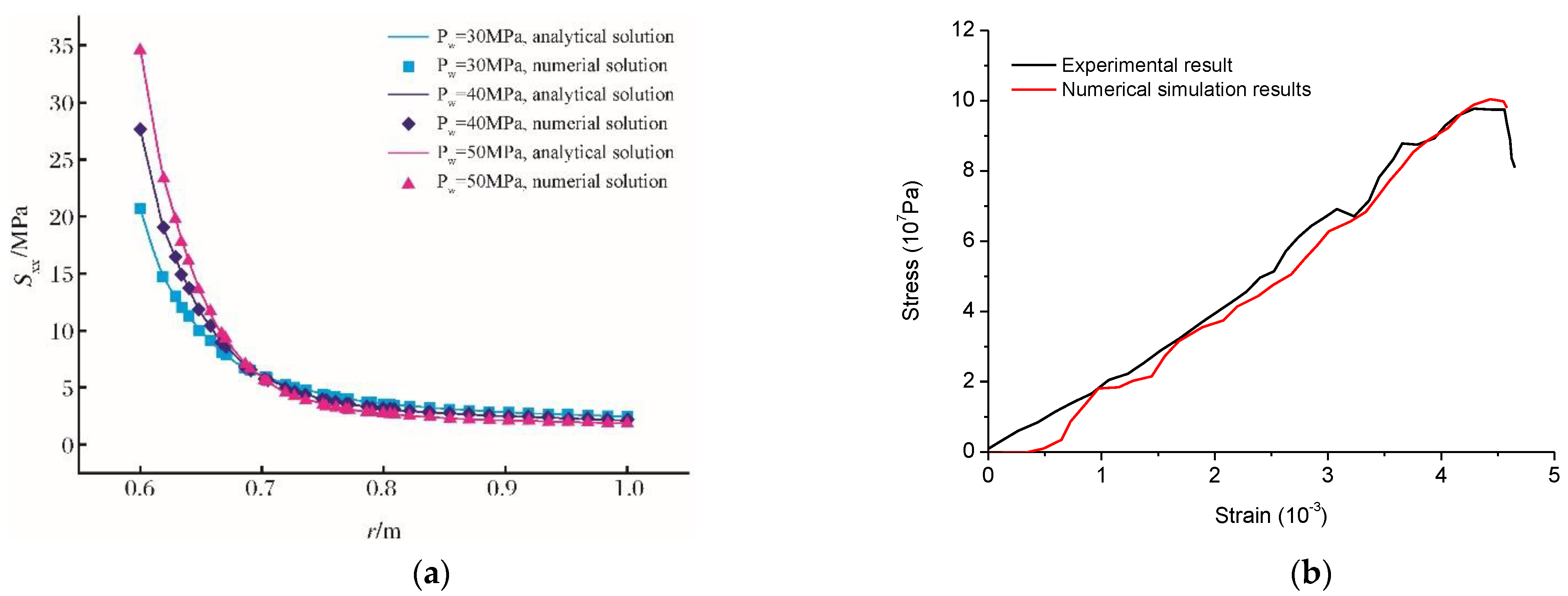
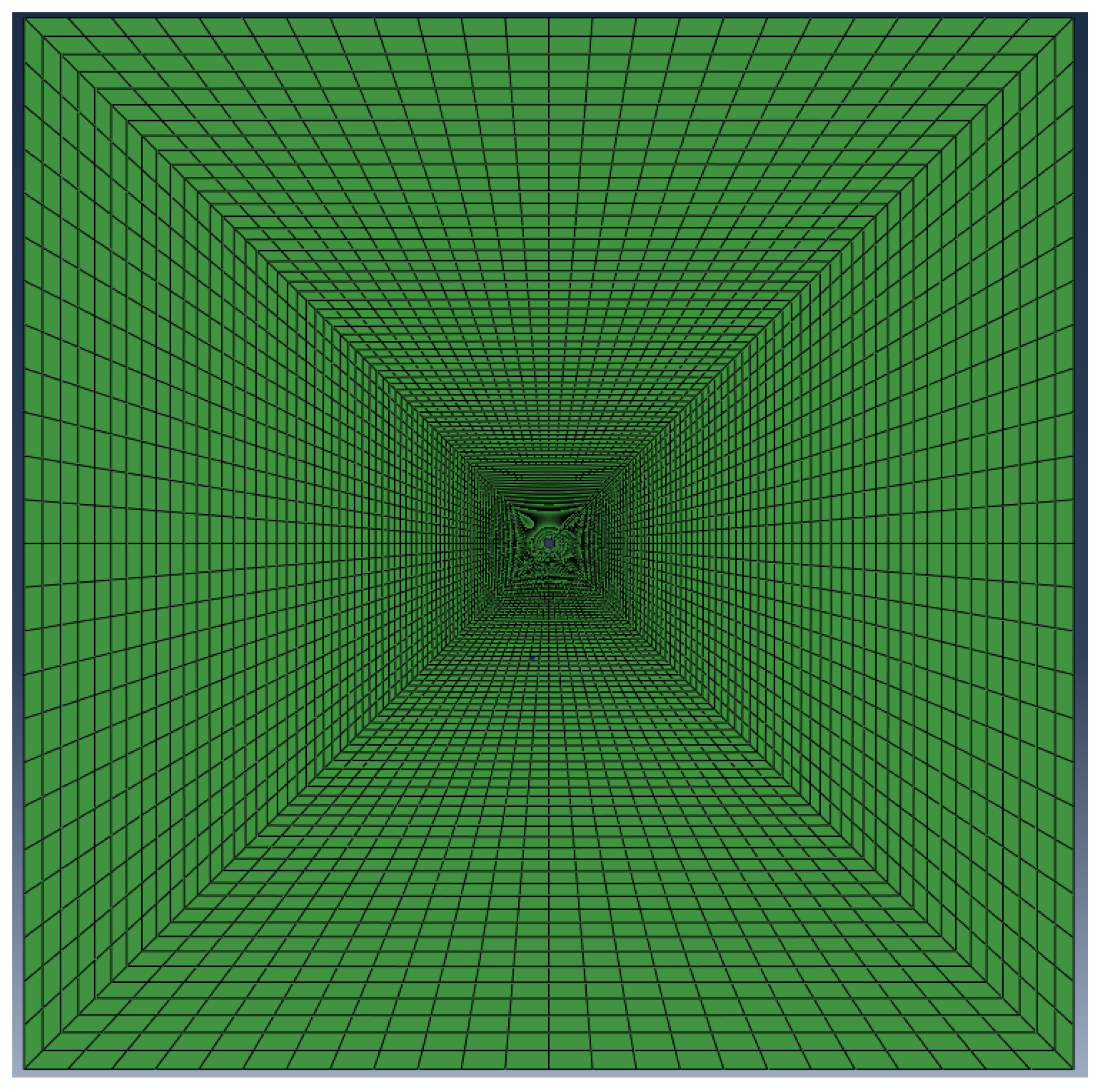
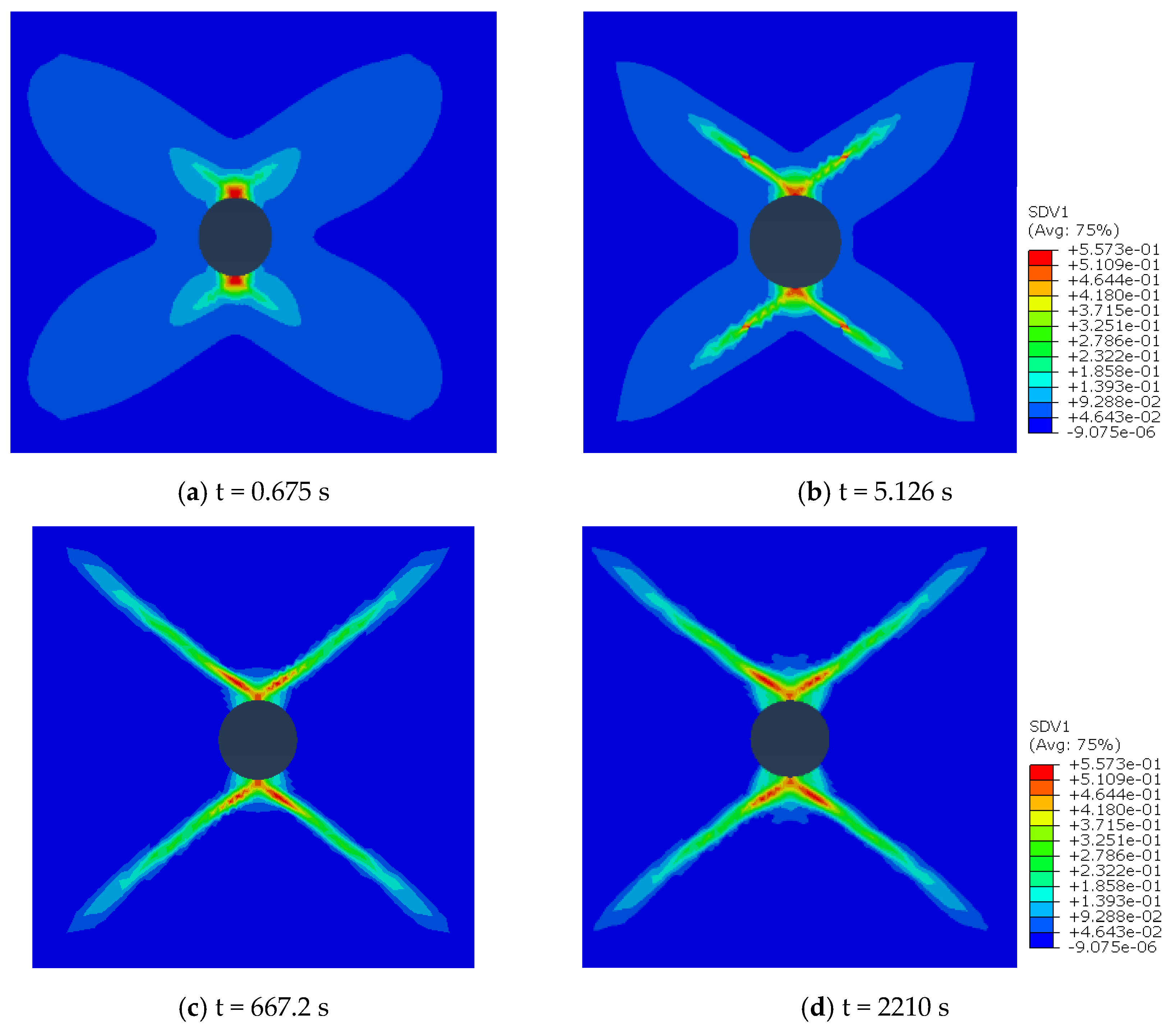


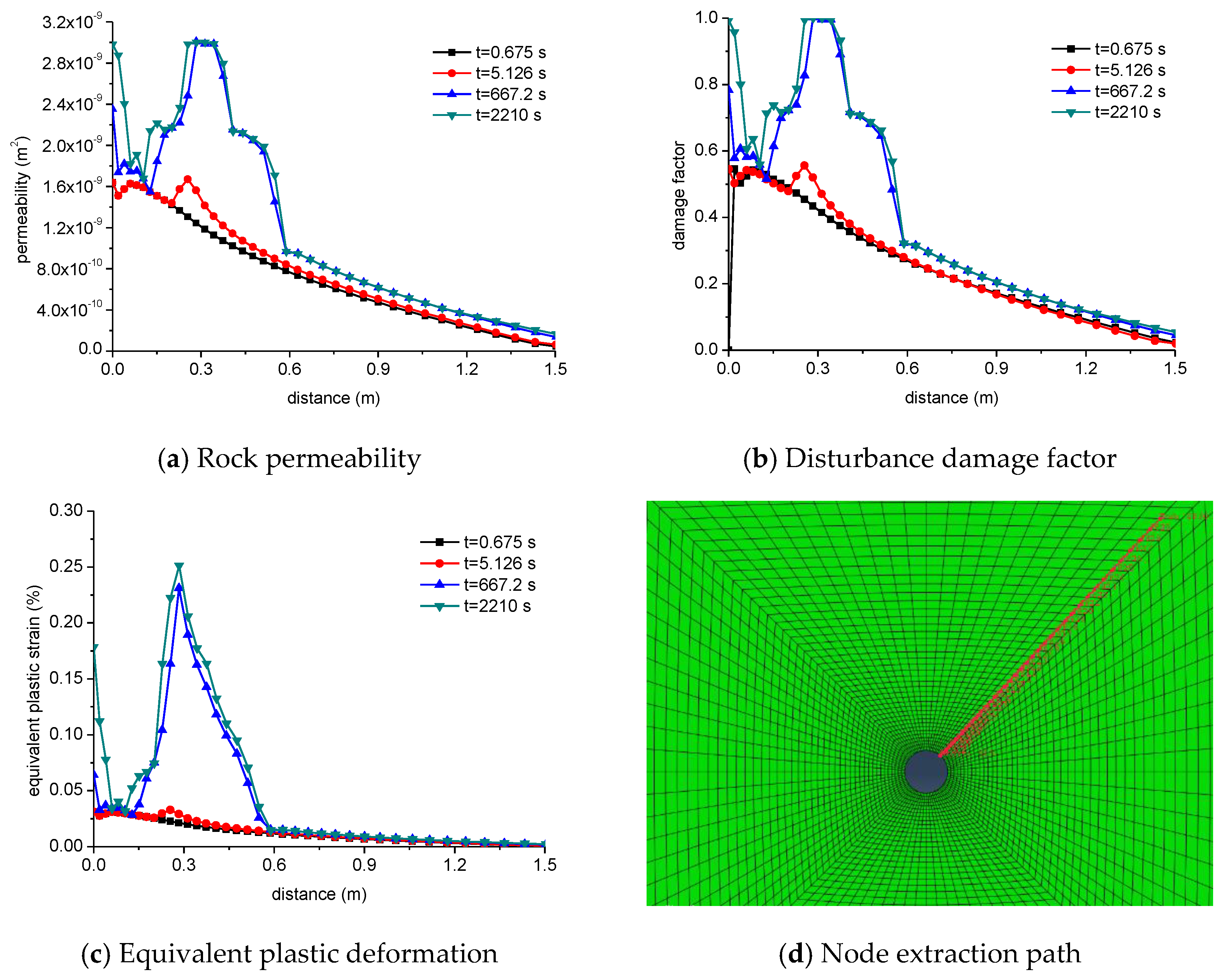
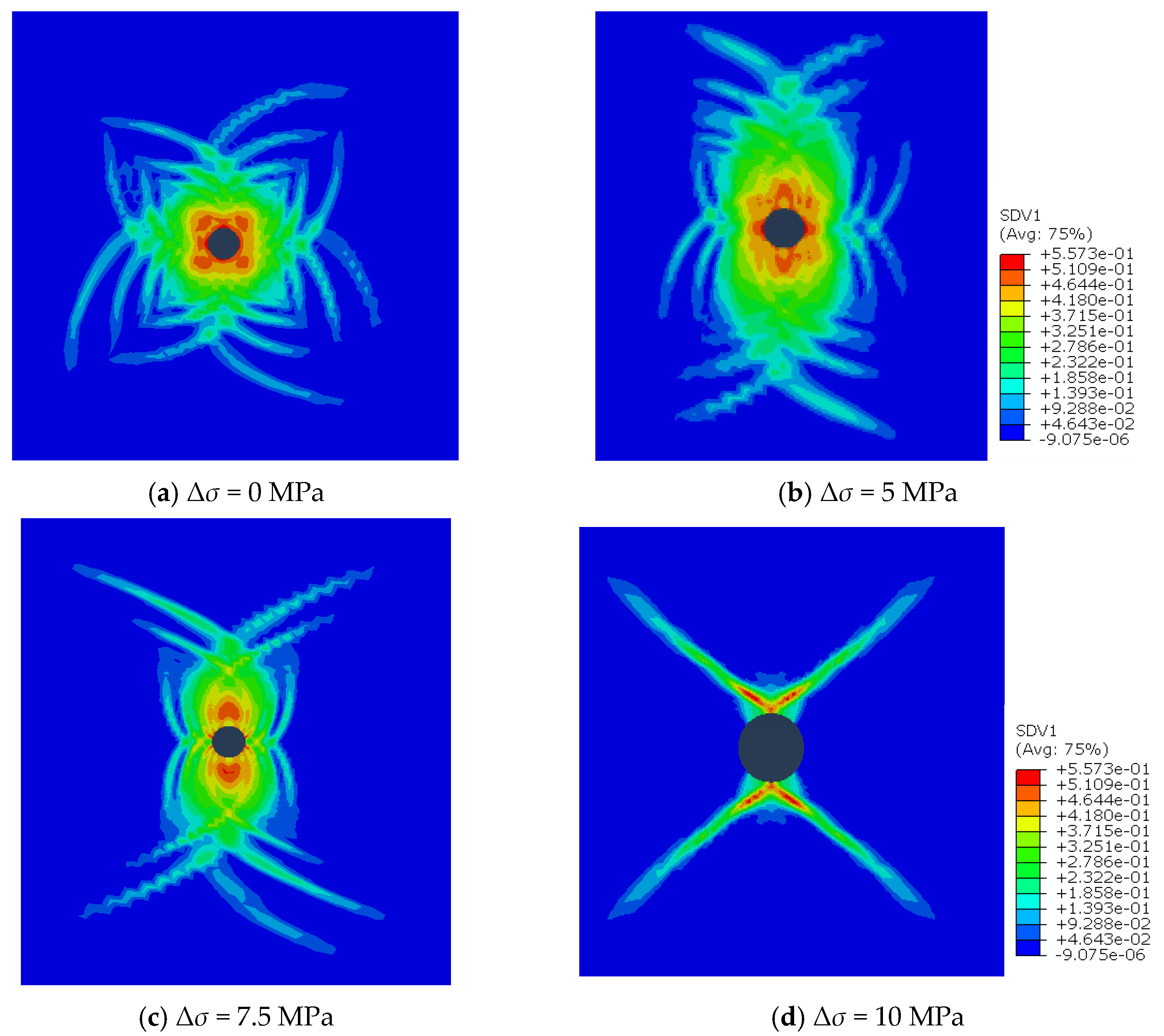
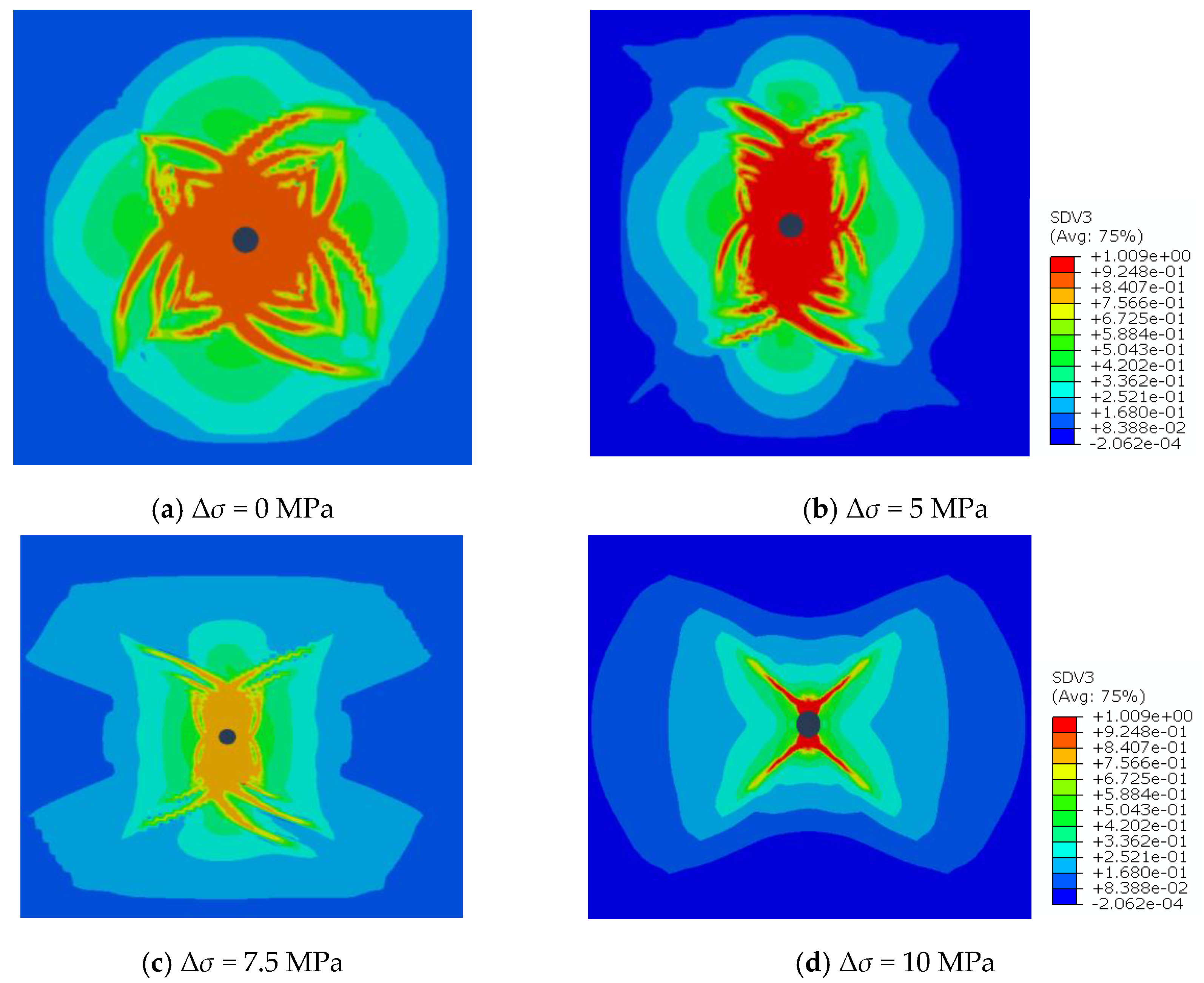
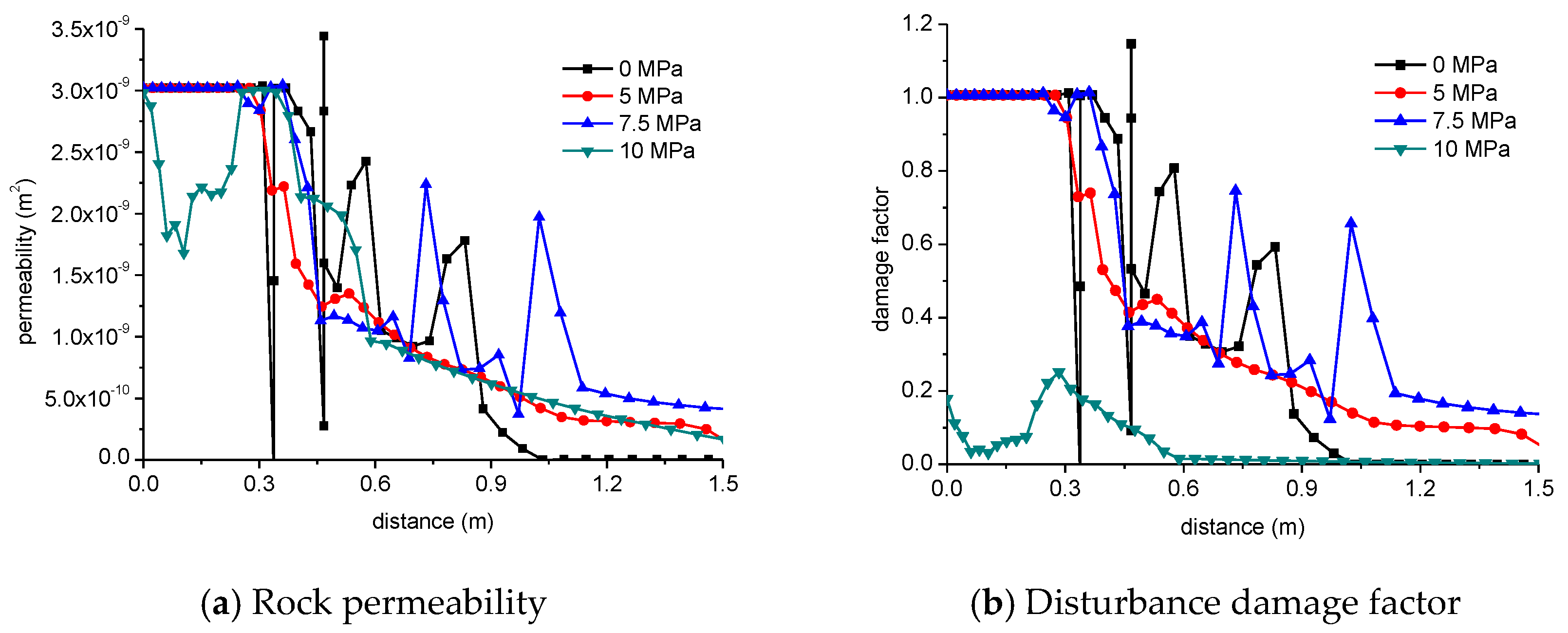
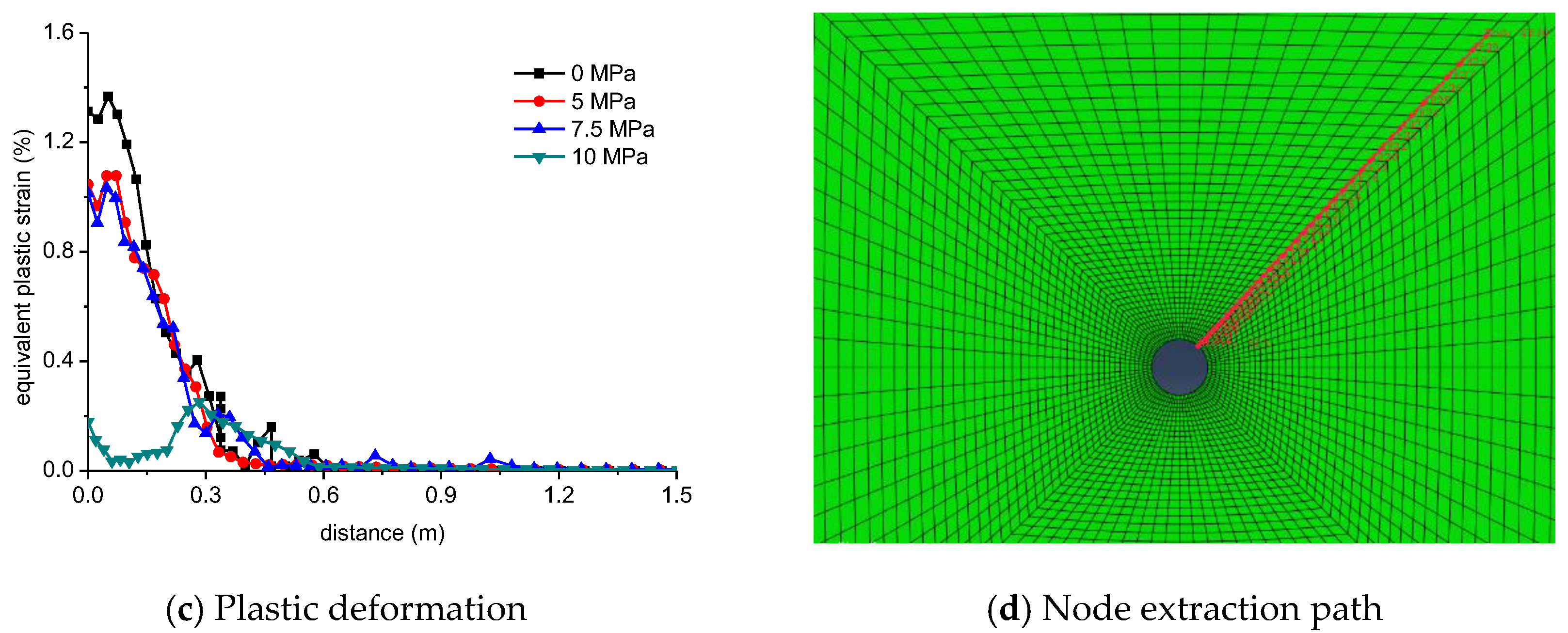
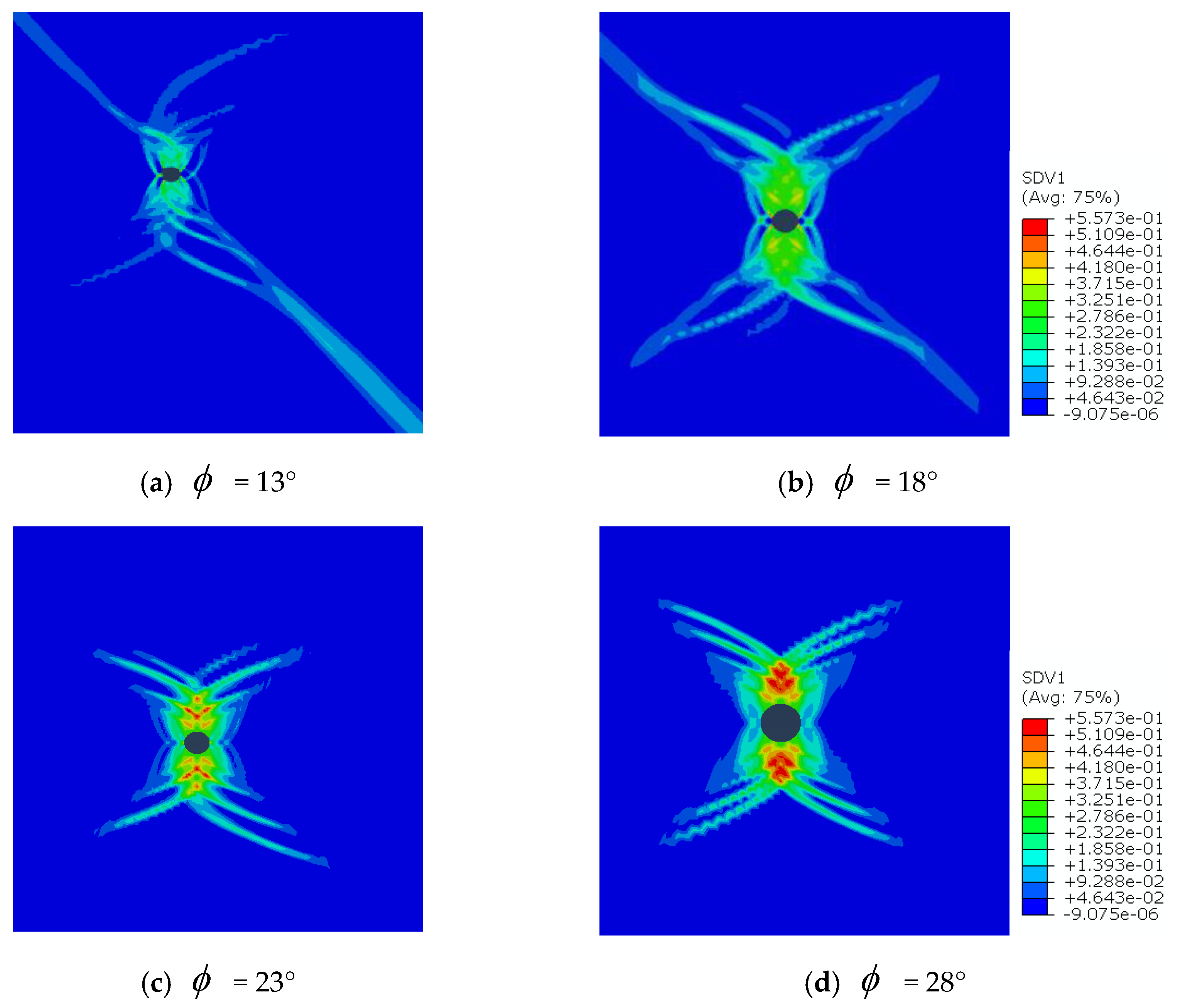
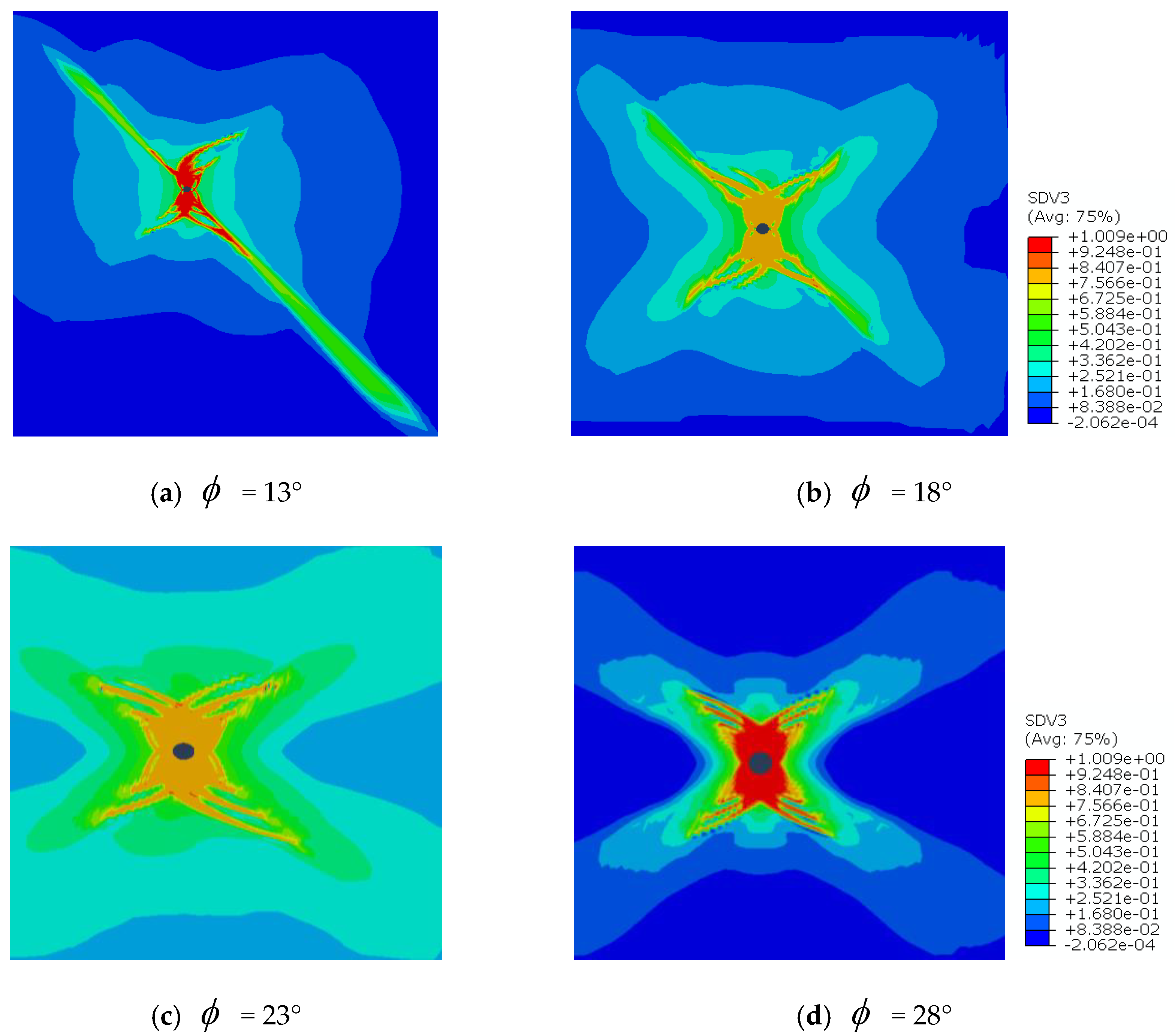
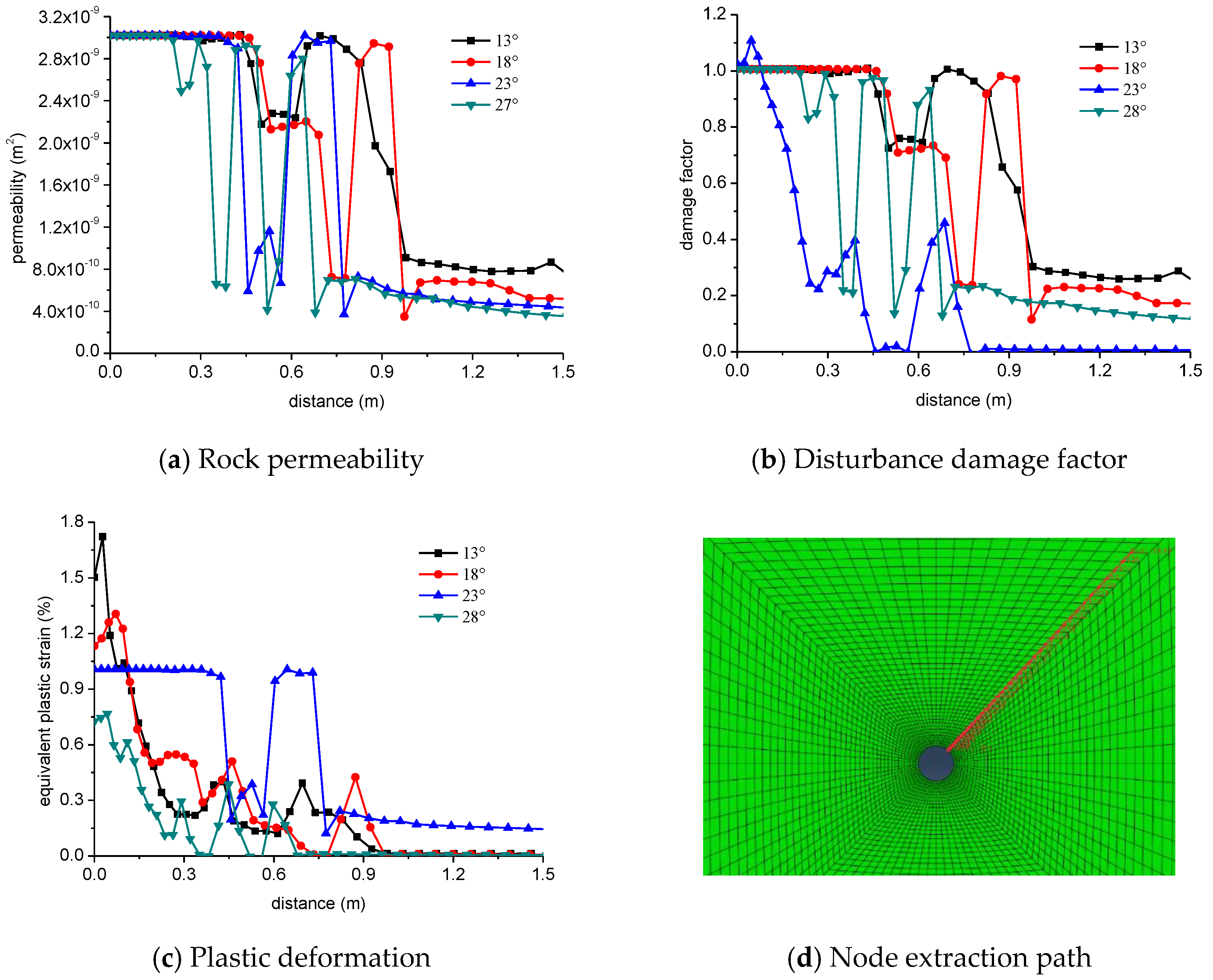

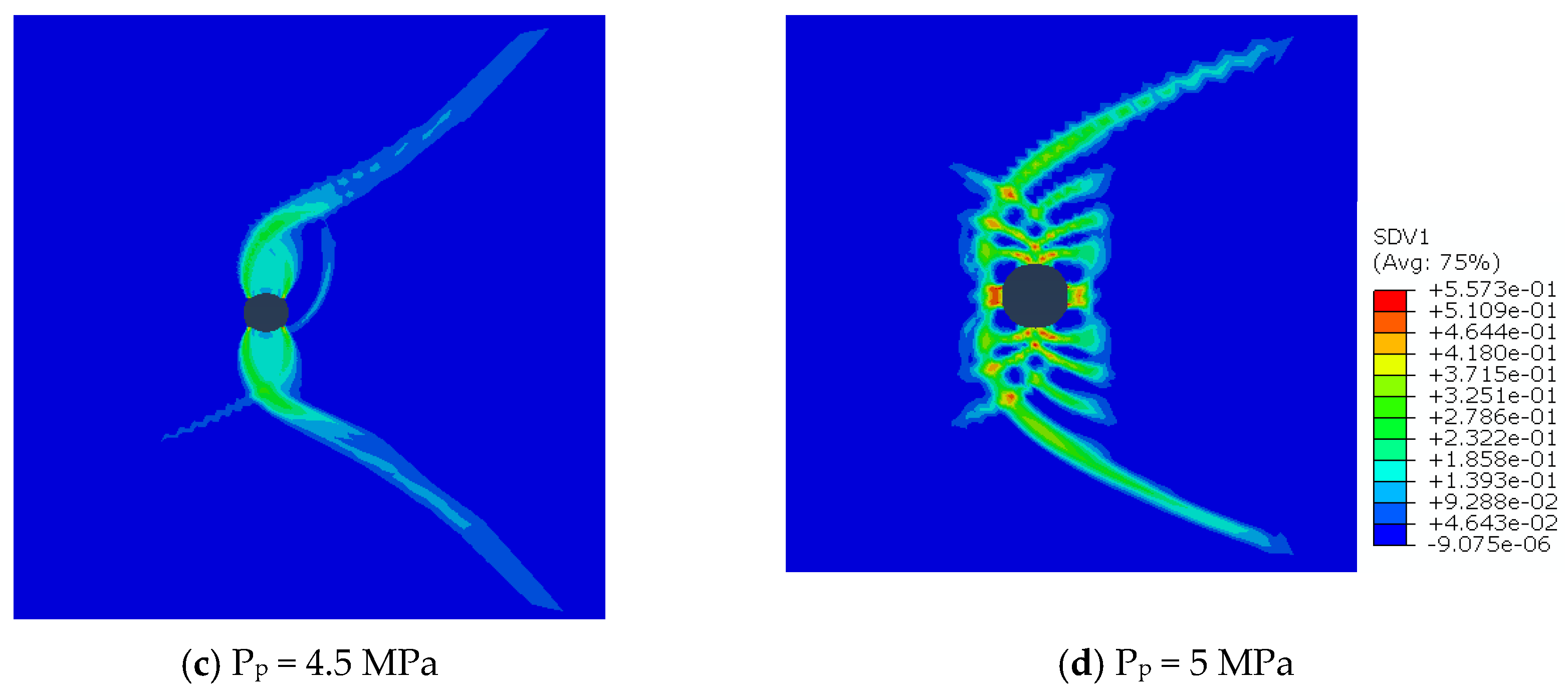
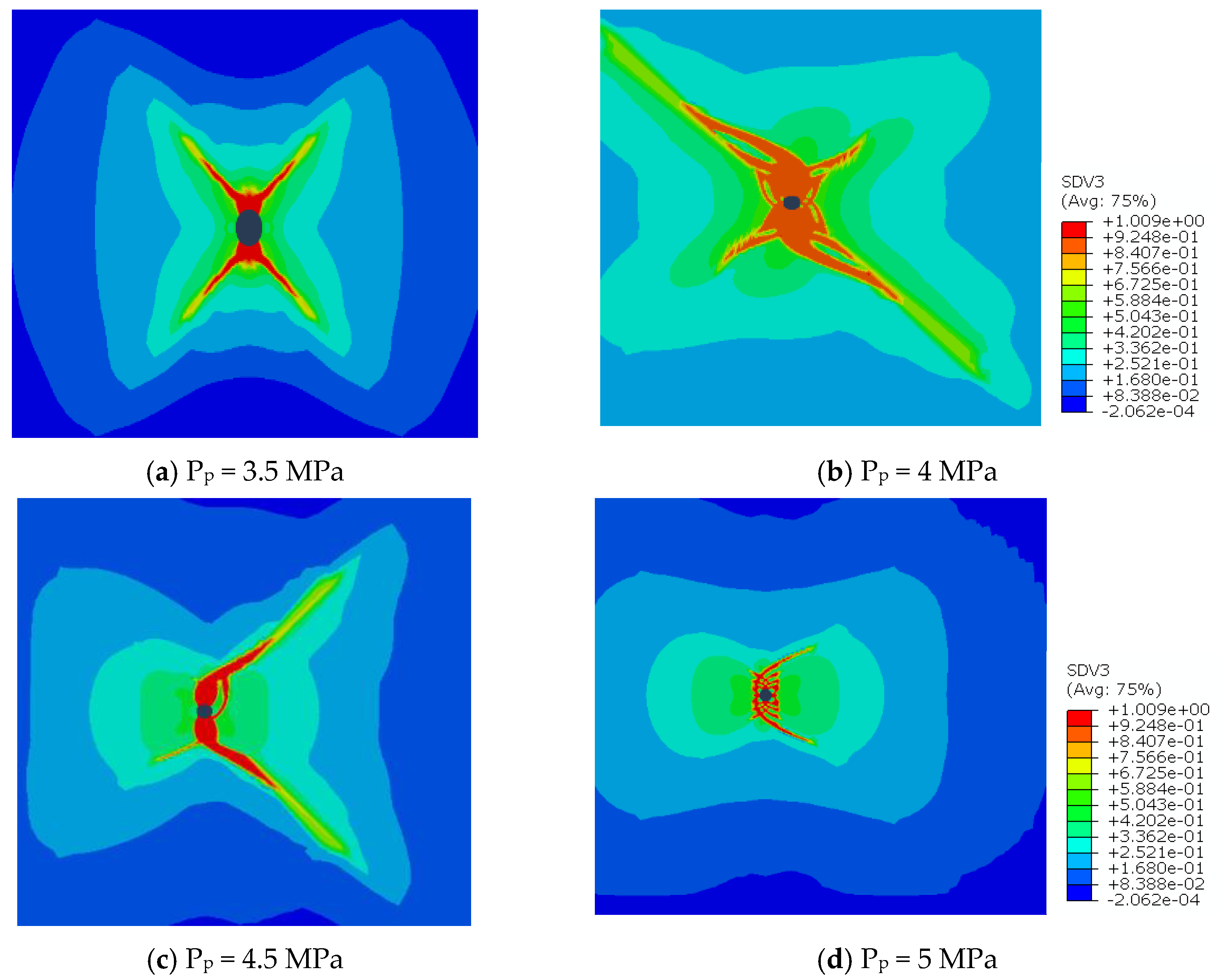
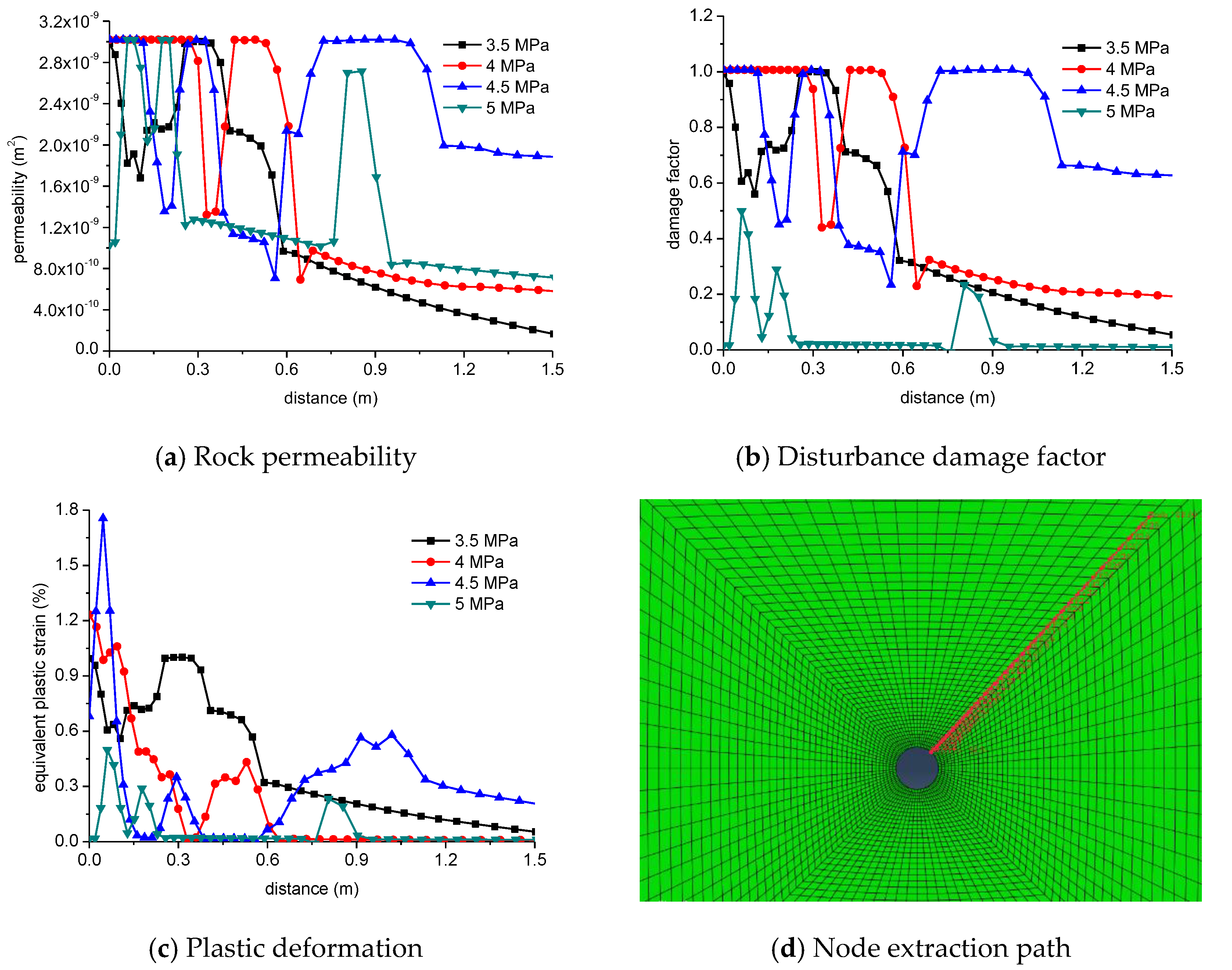
| Parameters | Value |
|---|---|
| Porosity/decimal | 0.05 |
| Poisson’s ratio/decimal | 0.25 |
| Elastic modulus/GPa | 34.5 |
| Rock density/kg/m3 | 2500 |
| Rock permeability/mD | 0.001 |
| Tensile strength/MPa | 6.04 |
| Uniaxial compressive strength/MPa | 100 |
| Internal friction angle of rock/° | 33.7 |
| Element damage evolution factor/decimal | 2 |
| Fluid density/kg/cm3 | 1020 |
| Fluid compression coefficient/1/Pa | 2 × 10−10 |
| Fluid viscosity/mPa·s | 1.8 |
| Initial formation pressure/MPa | 28 |
| Maximum horizontal principal stress/MPa | 40 |
| Minimum horizontal principal stress/MPa | 30 |
| Borehole radius/m | 0.1 |
| Injection time/s | 60 |
| Parameters | Value |
|---|---|
| Rock elastic modulus/Pa | 3 × 108 |
| Poisson’s ratio/decimal | 0.25 |
| Rock permeability/m2 | 3 × 10−12 |
| Porosity/decimal | 0.16 |
| Maximum horizontal principal stress/Pa | 2.75 × 106 |
| Minimum horizontal principal stress/Pa | 1.75 × 106 |
| Vertical stress/Pa | 3.5 × 106 |
| Rock cohesion/Pa | 3 × 105 |
| RInternal friction angle of rock/° | 18 |
| Dilation angle of rock/° | 0 |
| Initial pore pressure/Pa | 1.5 × 106 |
| Material parameter a/decimal | 0.2 |
Publisher’s Note: MDPI stays neutral with regard to jurisdictional claims in published maps and institutional affiliations. |
© 2022 by the authors. Licensee MDPI, Basel, Switzerland. This article is an open access article distributed under the terms and conditions of the Creative Commons Attribution (CC BY) license (https://creativecommons.org/licenses/by/4.0/).
Share and Cite
Wang, D.; Qu, Z.; Ren, Z.; Shan, Q.; Yu, B.; Zhang, Y.; Zhang, W. Numerical Simulation on Borehole Instability Based on Disturbance State Concept. Energies 2022, 15, 6295. https://doi.org/10.3390/en15176295
Wang D, Qu Z, Ren Z, Shan Q, Yu B, Zhang Y, Zhang W. Numerical Simulation on Borehole Instability Based on Disturbance State Concept. Energies. 2022; 15(17):6295. https://doi.org/10.3390/en15176295
Chicago/Turabian StyleWang, Daobing, Zhan Qu, Zongxiao Ren, Qinglin Shan, Bo Yu, Yanjun Zhang, and Wei Zhang. 2022. "Numerical Simulation on Borehole Instability Based on Disturbance State Concept" Energies 15, no. 17: 6295. https://doi.org/10.3390/en15176295
APA StyleWang, D., Qu, Z., Ren, Z., Shan, Q., Yu, B., Zhang, Y., & Zhang, W. (2022). Numerical Simulation on Borehole Instability Based on Disturbance State Concept. Energies, 15(17), 6295. https://doi.org/10.3390/en15176295








